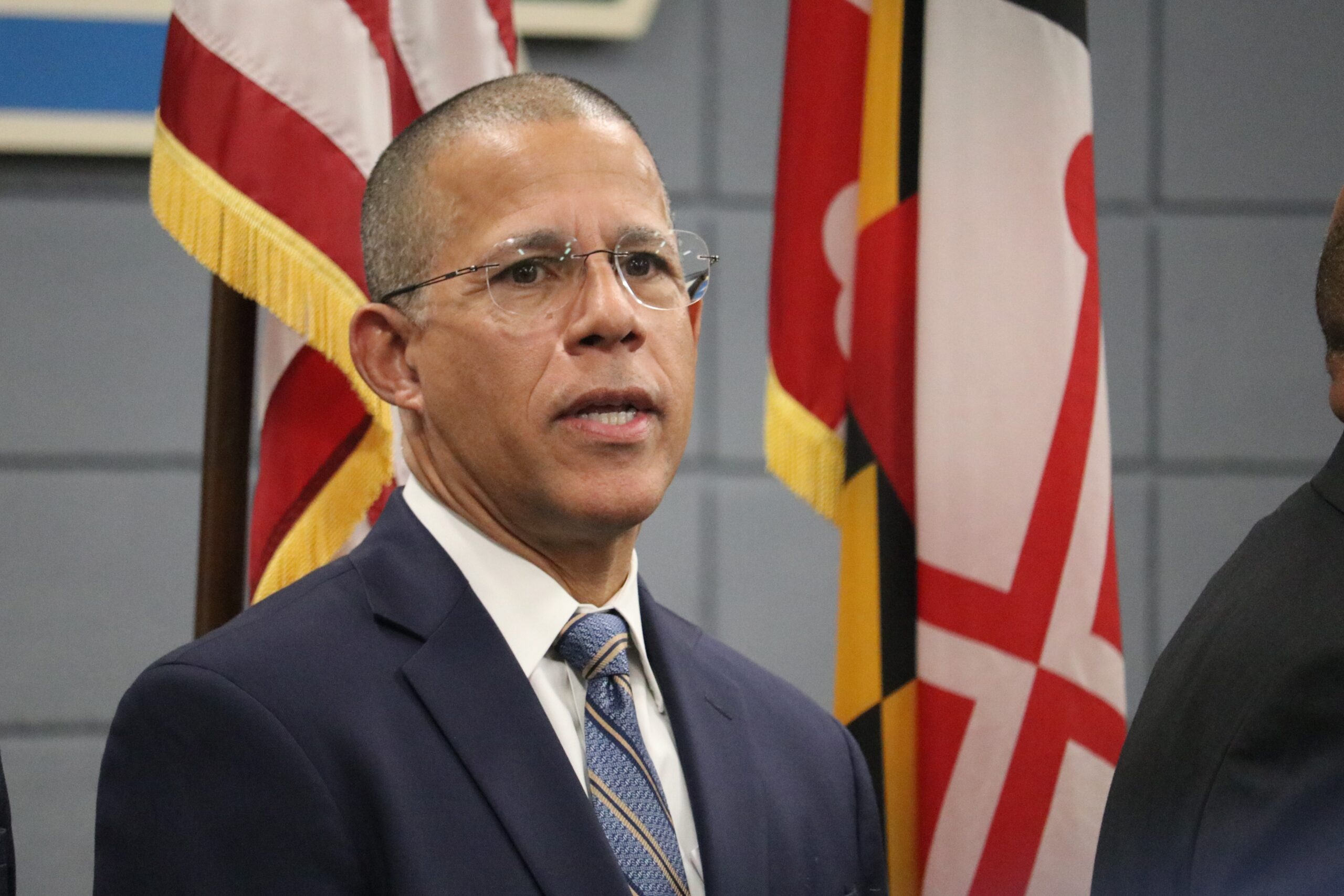“It was the best of times,
It was the worst of times,
It was the age of wisdom,
It was the age of foolishness
It was the epoch of belief,
It was the season of light,
It was season of darkness,
It was the spring of hope
It was the winter of despair.”
This is a tale of two Republican governors of Maryland, the first to be elected in the heavily Democratic state since the 1950s, one of them ejected from office after a single term and the other the first to be reelected since those dark ages.
Put another way, one made lemonade, and the other stuck with the lemons.
Sorry, Charles Dickens, to rattle your weary bones again, but timeless quotes are worth repeating as appropriate. (Dickens was fascinated with America, especially its hotels. His favorite was Baltimore’s Barnum’s Hotel, back then at North Calvert and Fayette Streets.)
But back to business.
The Republican governor of the moment, Larry Hogan, is almost a pandemic himself. He’s all over the place – on the screen, the airwaves, the Internet, and, occasionally, in the State House where he belongs.
The other Republican governor Robert L. Ehrlich Jr., is rarely seen nor heard these days, a forgotten man in a largely forgotten time which, if a reminder is necessary, was less than two decades ago, and again, when he tried to reclaim the governorship that he lost, a mere 10 years ago. But in politics, that’s a lifetime or two.

Frank A. DeFilippo
The latest connection here is that they’ve both published books (notice the use of the word published instead of written), Hogan’s being celebrated, or castigated, for different reasons, and Ehrlich’s tomes are largely forgotten or ignored but offer insights into his Zelig-like career in politics by comparison to Hogan’s staying power. (Zelig was Woody Allen’s celluloid character who could change appearance, behavior or beliefs to fit any situation.)
So the question is:
Bobby, Bobby, Bobby. What the hell happened?
Well, for one thing, his wife has a high-sounding job in the Trump administration. She was recently promoted from deputy director of the White House Office of National Drug Policy to director of the Justice Department’s sex offender programs.
And for another, Ehrlich became a specialist in government advocacy and public policy – er, sorry about the lawyerly verbosity. In plain English, make that a lobbyist.
Normally, that would be enough said.
But Ehrlich screwed up long before that.
Mort Sahl, the comedian, observed that anyone who maintains a consistent political philosophy will eventually be tried for treason. Ehrlich needn’t worry.
He began his political career in the House of Delegates in its bonhomie days as a go-along, get-along Republican in a lopsided mix of Democrats who controlled the whole works.
Ehrlich then went to Congress and Zelig took his first turn. Ehrlich became a certified member of Speaker Newt Gingrich’s 1994 “Contract with America” crowd. Essentially, the contract was a 10-point campaign document. It promised procedural reforms in the House, term-limits, fiscal responsibility, shrinking government, and a promise to gut welfare, among other rambunctious changes. Some succeeded, most failed, as it should have been.
But Gingrich was forced to resign as speaker 1999 and gone from the House. Ehrlich soon became a protégé of Gingrich’s successor as speaker, Dennis Hastert, of Illinois. Ehrlich’s lurch to the right became even more pronounced as he rose through the ranks under Hastert’s patronage. (Hastert resigned, too, in 2007. He was later charged with financial crimes and repeated incidents of child molestation.)
Ehrlich, by now fully spun, saw an opening in the Maryland governor’s race in 2002, as did Hogan, later, in 2014. Maryland voters have never promoted a lieutenant governor to governor since the office of understudy was reconstituted in 1970.
In Ehrlich’s case, the Democrats nominated Gov. Parris Glendening’s second banana, Kathleen Kennedy Townsend, as their candidate for governor. And to Hogan’s advantage, the Democrats went with Anthony Brown, back-up to Gov. Martin O’Malley, and now a congressman from Prince George’s County and a mentionable to succeed the term-limited Hogan in 2022.
While the procedures of Congress might have changed slightly while Ehrlich was there, he returned to the State House where the rules of engagement remained as back-slapping and your only currency is your word. Anyone would have though Zelig would immediately engage to his former methods of doing business.
It was a disaster. Ehrlich was stuck with raising taxes because of the unpaid bills Glendening left behind and the unnecessary – and unanticipated – tax cut that Glendening offered and the General Assembly couldn’t refuse.
Ehrlich tried hoops and pizza with the b’oys in the General Assembly, and that didn’t work, either. There were other volatile issues that jammed Ehrlich, such as utility rates, but Ehrlich was out after one term. Democrats were ready for a comeback, and they awarded O’Malley a resume upgrade from mayor of Baltimore to governor of Maryland. The Ehrlich paradox was that he was booted out of office while enjoying a 55% voter approval rating in the polls.
Ehrlich’s attempted reelection campaign in 2010 hit a how-low-can-you-go mark, too. The campaign got caught busing in Black people from Philadelphia to work the polls in Prince George’s County. And two of his top campaign operatives were involved in robocalls that were judged to be attempts to suppress the Black vote.
One of the operatives was the ubiquitous Julius Henson, who had offered his services to Ehrlich in his first campaign for a staggering fee but was rejected, but now was a salaried employee in the second campaign.
Read where Ehrlich stands now. His first book (published, incidentally, by the same publisher as Hogan’s book) was called “Turn This Car Around.” More than that, the blurb sounds as if the car comes to a screeching halt, makes its U-turn and parks in a reserved slot at the White House. Ehrlich appears to have gone full Trump.
The blurb calls for action on union strangleholds, Obamacare, a failed stimulus package, soaring energy costs, high unemployment, the race card, the living wage ware, bipartisanship, and other combustible topics calculated to pop the blood pressure cuff. Listen carefully and you can hear the Trumpster applauding in the background.
Was Ehrlich always this way, and did he just hide it well?
But therein lies the difference between Ehrlich’s decline and fall, and the success and staying power of Hogan in a state as progressive as Maryland.
Hogan’s book is more anecdotal, like his life, a tempered succession of personal setbacks and political achievements and failures – his battle with cancer, the pandemic and with a detour for a personal cheap-shot at Baltimore which he must feel is necessary to assuage his natural constituents outside of the I-95 corridor in the bleached counties of outer Marylandia. His standing in the polls remains stratospheric.
Hogan has proved to be a pretty nimble politician, giving Democrats much of what they want and picking his fights carefully, mostly on big-ticket fiscal items and his insistence on a tighter criminal justice policy and punishment, again aimed at Baltimore and its consistently high crime rate. It doesn’t matter very much, though. Democrats have overridden his vetoes in wholesale fashion, and Hogan has allowed many Democratic bills to become law without his signature, tacitly revealing his objections but allowing the laws to flow.
Currently he is embroiled in a nasty fight over voting procedures for the November elections and questions about his purchase of Korean coronavirus testing kits as well as political influence on another purchasing contract by one of his staffers.
The breathless title of Hogan’s memoir, more personal than polemic, is a certain give-away to its chatty content: “Still Standing: Surviving Cancer, Riots and the Toxic Politics that Divide America.”
The book is being viewed, and reviewed, as kind of an application for entry into the 2024 contest for the presidency. But another, and more likely view is that the book more of an extension of his current assignment as chairman of the National Governors Association, a national platform that expires shortly.
Hogan has said that he wants a voice, and a loud one, in reshaping, or restoring, whichever, the Republican Party to its former grandeur when the Trump debacle concludes, this year or, perilously, later.
And while Ehrlich appears to be toadying up to the Trump agenda of governance, Hogan has, alternatively, stepped up his criticism of the president, notably Trump’s shoot-from-the-lip, scattershot ad-libs that lead only to bewildering self-destruction.
The White House shot back at Hogan. It accused him of double-talk by comparing his criticism of Trump with his earlier praise of the president for his direct and frank communications with the nation’s governors.
Hogan may find, however that when his chairmanship ends and the chatter over his book dies down, his voice may be muffled, just as Ehrlich’s has, but for different reasons. Next year, for example, Hogan will still be governor, but much of the attention will shift to the General Assembly and the state’s fiscal problems as well as the line-up of prospective candidates to succeed him, which carries over into the following election year, when all distracting hell breaks loose.
Two Maryland Republican governors, two different views of the immediate world, and two different cures. Hogan and Ehrlich have now left paper trails of their lives and times and how they dealt with them as elected officials.
Both have succeeded, probably well beyond each of their expectations. Interestingly, Hogan worked in the State House as Ehrlich’s appointments (patronage) secretary. It turns out, as life does in one of those toothsome twists, that the staffer had better survival skills than the boss.





 Creative Commons Attribution
Creative Commons Attribution